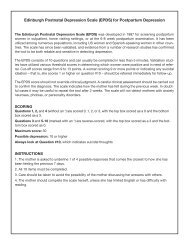Clinical 3D ultrasound imaging: beyond obstetrical applications
Clinical 3D ultrasound imaging: beyond obstetrical applications
Clinical 3D ultrasound imaging: beyond obstetrical applications
Create successful ePaper yourself
Turn your PDF publications into a flip-book with our unique Google optimized e-Paper software.
CLINICAL <strong>3D</strong> ULTRASOUND IMAGING:BEYOND OBSTETRICAL APPLICATIONSFIGURE 3.Axial, sagittal, reconstructed coronal, and volumetric images of sonohysterogram demonstrate endometrialpolyps.Volumetric image displays both polyps in one image and shows their orientation relative to each otherand uterine cavity. (Provided by Siemens Medical Solutions)segmentation (22).Another dramatic advantage is visualizationof an entire valve at a given timepoint or cinematically throughout thecardiac cycle (23). Other advantagesinclude improved visualization of septaldefects and assessment of anatomic relationshipsin congenital heart disease (24).ULTRASOUND-GUIDEDINTERVENTIONSUltrasound’s real-time visualization capabilityhas well-established benefits inguidance of both minimally invasive andoperative interventional procedures.While many surgical specialties may benefitfrom <strong>3D</strong> <strong>ultrasound</strong> technology, itsapplication to neurosurgical procedureshas prompted particularly rapid adoptionand intensive research. Continuous intraoperativemonitoring of <strong>3D</strong> brain shift isvery useful during resection of intracranialtumors. This information allows asurgeon to modify preoperative planningmaps to account for warping and tissueremoval (25).Doppler <strong>imaging</strong> allows for improvedvisualization of vasculature of interest(26). This is beneficial in a variety of procedures,including biopsy guidance,resection guidance, arteriovenous malformationlocalization (and involved vesselidentification), localization of peripheralaneurysms, and delineation of cavernoushemangiomas in both brainparenchyma and the brain stem (27,28).For glioma resection, <strong>3D</strong> <strong>ultrasound</strong>volumes provide delineation of metastasesand solid component at least as reliablyas navigated <strong>3D</strong> MRI (29). UnlikeMRI-based navigation, no preoperativedata set is required, and thus craniotomydoes not affect navigational accuracy.LIMITATIONS OF <strong>3D</strong> ULTRASOUNDWhile <strong>3D</strong> <strong>ultrasound</strong> demonstratesmuch promise, several limitations andpitfalls remain that must be considered tosuccessfully integrate the technology inclinical practice.First, <strong>3D</strong> image acquisition is logisticallybut not fundamentally differentfrom 2D <strong>ultrasound</strong>. The source of contrast— acoustic impedance differences— is identical, so current contrast limitationsstill apply. In obstetrics, whereamniotic fluid provides high contrastbetween the background and the fetalsurface, <strong>3D</strong> renderings provide impressiveverisimilitude, but in other organ systems,the effects have been less dramatic.Second, user interfaces are complexand challenging to master. No standardizeddisplay convention has emerged todate for the reconstructed images, soimage orientation can be difficult todetermine. Common artifacts used forcharacterization, such as posteriorenhancement, are more difficult to interpretin the context of multiple simultaneoustransducer orientations.Third, while most 2D studies are standardizedon a per-organ or per-indicationbasis, currently no standard methodolo-FIGURE 4. A. Axial breast <strong>ultrasound</strong> image demonstrates lobulated mass with refractive edge shadowing.B. Coronal reconstructed image demonstrates intraductal location of mass. (Provided by GE HealthcareTechnologies)January 2007 DIAGNOSTIC IMAGING: CONTINUING MEDICAL EDUCATION 4
CLINICAL <strong>3D</strong> ULTRASOUND IMAGING:BEYOND OBSTETRICAL APPLICATIONSgy for <strong>3D</strong> data set acquisition or interpretationexists.Fourth, rendering of data in <strong>3D</strong> usingvolume or surface rendering techniquesintroduces an additional layer of potentialartifacts and lack of standardized review.Finally, while <strong>3D</strong> images are qualitativelymore intuitive than traditional 2Dsections, data as to the quantitative clinicalbenefits of <strong>3D</strong> <strong>ultrasound</strong> <strong>imaging</strong> arelimited, particularly compared with thevast volume of literature and expertiseavailable for 2D <strong>imaging</strong>. Thus, moreresearch is required to identify the benefitsand indications for <strong>3D</strong> <strong>imaging</strong>.CONCLUSIONThree-D <strong>ultrasound</strong> is an emergingmodality that extends the scope andpotentially improves the clinical utility of2D <strong>ultrasound</strong> for a variety of organ systemsand indications. Unlike 2D <strong>ultrasound</strong>,<strong>3D</strong> technology is only in its infancy.Undoubtedly, the next decade will seeboth technological refinement andincreased standardization of <strong>3D</strong> <strong>ultrasound</strong>evaluation. Thus, <strong>3D</strong> <strong>ultrasound</strong> isa frontier that has been discovered but isyet to be settled. ■REFERENCES1. Fenster A, Downey DB. Three-dimensional <strong>ultrasound</strong> <strong>imaging</strong>.Annu Rev Biomed Eng 2000;2:457-475.2. Fritz GA, Riccabona M, Weitzer C, et al. Three-dimensional<strong>ultrasound</strong> (<strong>3D</strong>US) of the neonatal brain: clinical application inpatients of the neonatal intensive care unit (NICU). UltraschallMed 2005;26(4):299-306.3. Nelson TR, Pretorius DH, Lev-Toaff A, et al. Feasibility of performinga virtual patient examination using three-dimensionalultrasonographic data acquired at remote locations. J UltrasoundMed.2001;20(9):941-952.4. Benacerraf BR, Benson CB, Abuhamad AZ, et al. Three- and4-dimensional <strong>ultrasound</strong> in obstetrics and gynecology: proceedingsof the american institute of <strong>ultrasound</strong> in medicine consensusconference. J Ultrasound Med 2005;24(12):1587-1597.5. Benacerraf BR, Shipp TD, Bromley B. Three-dimensional USof the fetus: volume <strong>imaging</strong>. Radiology 2006;238(3):988-996.6. Bega G, Lev-Toaff AS, O’Kane P, et al. Three-dimensionalultrasonography in gynecology: technical aspects and clinical<strong>applications</strong>. J Ultrasound Med 2003;22(11):1249-1269.7. Hirahara N, Ukimura O, Ushijima S, et al. Four-dimensionalultrasonography for dynamic bladder shape visualization andanalysis during voiding. J Ultrasound Med 2006;25(3):307-313.8. Mitterberger M, Pinggera GM, Neuwirt H, et al. Three-dimensionalultrasonography of the urinary bladder: preliminary experienceof assessment in patients with haematuria. BJU Int 2006;Oct11 [Epub ahead of print].9. Sauvain JL, Palascak P, Bourscheid D, et al. Value of powerdoppler and <strong>3D</strong> vascular sonography as a method for diagnosisand staging of prostate cancer. Eur Urol 2003;44(1):21-30; discussion30-31.10. Bogers HA, Sedelaar JP, Beerlage HP, et al. Contrastenhancedthree-dimensional power Doppler angiography of thehuman prostate: correlation with biopsy outcome. Urology1999;54(1):97-104.11. Cho N, Moon WK, Cha JH, et al. Differentiating benign frommalignant solid breast masses: comparison of two-dimensional andthree-dimensional US. Radiology 2006;240(1):26-32.12. Kripfgans OD, Rubin JM, Hall AL, et al. Measurement of volumetricflow. J Ultrasound Med 2006;25(10):1305-1311.13. Forsberg F, Rawool NM, Merton DA, et al. Contrastenhanced vascular three-dimensional <strong>ultrasound</strong> <strong>imaging</strong>.Ultrasonics 2002;40(1-8):117-122.14. Fenster A, Blake C, Gyacskov I, et al. <strong>3D</strong> <strong>ultrasound</strong> analysisof carotid plaque volume and surface morphology. Ultrasonics2006;Jun 30 [Epub ahead of print].15. Landry A, Spence JD, Fenster A. Quantification of carotidplaque volume measurements using <strong>3D</strong> <strong>ultrasound</strong> <strong>imaging</strong>.Ultrasound Med Biol 2005;31(6):751-762.16. Bainbridge D. 3-D <strong>imaging</strong> for aortic plaque assessment.Semin Cardiothorac Vasc Anesth 2005;9(2):163-165.17. Landry A, Spence JD, Fenster A. Measurement of carotidplaque volume by 3-dimensional <strong>ultrasound</strong>. Stroke2004;35(4):864-869.18. Harrer JU, Wessels T, Poerwowidjojo S, et al. Three-dimensionalcolor-coded duplex sonography for assessment of the vertebralartery origin and vertebral artery stenoses. J Ultrasound Med2004;23(8):1049-1056.19. AbuRahma AF, Jarrett K, Hayes DJ. <strong>Clinical</strong> implications ofpower Doppler three-dimensional ultrasonography. Vascular2004;12(5):293-300.20. Bucek RA, Reiter M, Dirisamer A, et al. Three-dimensionalcolor Doppler sonography in carotid artery stenosis. AJNR2003;24(7):1294-1299.21. Klotzsch C, Bozzato A, Lammers G, et al. Contrast-enhancedthree-dimensional transcranial color-coded sonography ofintracranial stenoses. AJNR 2002;23(2):208-212.22. Ota T, Kisslo J, von Ramm OT, Yoshikawa J. Real-time, volumetricechocardiography: usefulness of volumetric scanning forthe assessment of cardiac volume and function. J Cardiol 2001;37Suppl 1:93-101.23. Chan KL, Liu X, Ascah KJ, et al. Comparison of real-time 3-dimensional echocardiography with conventional 2-dimensionalechocardiography in the assessment of structural heart disease. JAm Soc Echocardiogr 2004;17(9):976-980.24. Houck RC, Cooke JE, Gill EA. Live <strong>3D</strong> echocardiography: areplacement for traditional 2D echocardiography? AJR2006;187(4):1092-1106.25. Lindner D, Trantakis C, Renner C, et al. Application of intraoperative<strong>3D</strong> <strong>ultrasound</strong> during navigated tumor resection.Minim Invasive Neurosurg 2006;49(4):197-202.26. Rygh OM, Cappelen J, Selbekk T, et al. Endoscopy guided byan intraoperative <strong>3D</strong> <strong>ultrasound</strong>-based neuronavigation system.Minim Invasive Neurosurg 2006;49(1):1-9.27. Unsgaard G, Rygh OM, Selbekk T, et al. Intra-operative <strong>3D</strong><strong>ultrasound</strong> in neurosurgery. Acta Neurochir (Wien)2006;148(3):235-253; discussion 253.28. Woydt M, Horowski A, Krauss J, et al. Three-dimensionalintraoperative <strong>ultrasound</strong> of vascular malformations and supratentorialtumors. J Neuro<strong>imaging</strong> 2002;12(1):28-34.29. Unsgaard G, Selbekk T, Brostrup Muller T, et al. Ability ofnavigated <strong>3D</strong> <strong>ultrasound</strong> to delineate gliomas and metastases —comparison of image interpretations with histopathology. ActaNeurochir (Wien) 2005;147(12):1259-1269; discussion 1269.POST-TEST INSTRUCTIONSTo take your post-test and receive CME credit, go to http://education.cmellc.com1. Login using your email address and password or “register now” if you are a first-time user2. Click on CME Programs3. Click on “<strong>Clinical</strong> Three Dimensional Ultrasound Imaging: Beyond Obstetrical Applications” in the list of programs4. Click on “Take Exam” at the bottom, left side of the page to complete your post-test5. After receiving a passing grade on the post-test, follow the online instructions to complete your evaluation and print yourstatement of credit.Reference #: A07019012Release Date: JAN 2007Expiration Date: JAN 2009Number of AMA PRA Credits Designatedfor this Activity: 1.0To earn AMA PRA Category 1 Credits read the article and complete the posttest and the evaluation. (Note: A score of at least 70% must be achieved inorder to be awarded credit.) The post test will be scored instantly and resultswill be shown onscreen. You will have the option of printing out a web-generatedStatement of Educational Credits Earned. Please make a copy of yourtest results and your “Statement” for your continuing education records. NOOTHER STATEMENT OF CREDITS EARNED OR CERTIFICATE WILL BE ISSUED.Please be aware that the accreditation and educational credit information onthis web page is current and accurate as of the last update. This may supersedeinformation contained in your printed article.CME LLC is accredited by the Accreditation Council for Continuing MedicalEducation to provide continuing medical education for physicians.CME LLC designates this program for a maximum of 1.0 AMA PRA Category1 Credits. Physicians should only claim credit commensurate with theextent of their participation in the activity.The American College of Radiology (ACR) accepts activities designated forAMA PRA Category 1 Credits.Physician Assistants: The American Academy of Physician Assistants (AAPA)accepts AMA PRA Category 1 Credits from organizations accredited by theACCME.Nurses: The American Nurses Credentialing Center (ANCC) accepts AMA PRACategory 1 Credits toward recertification requirements.CME LLC is approved by the California Board of Registered Nursing, ProviderNo. CEP12748, and designates this educational activity for 1.0 contacthours for nurses.©2007 CMPMEDICA • CME ULTRASOUND • CLINICAL <strong>3D</strong> ULTRASOUND IMAGING: BEYOND OBSTETRICAL APPLICATIONSJanuary 2007 DIAGNOSTIC IMAGING: CONTINUING MEDICAL EDUCATION 5
CLINICAL <strong>3D</strong> ULTRASOUND IMAGING:BEYOND OBSTETRICAL APPLICATIONSFor further readingGuerriero S, Ajossa S, Piras S, et al. Three-dimensionalquantification of tumor vascularity as a tertiarytest after B-mode and power Doppler evaluationfor detection of ovarian cancer. J UltrasoundMed 2007;26(10):1271-1278.Jokubkiene L, Sladkevicius P, Valentin L. Doesthree-dimensional power Doppler <strong>ultrasound</strong> helpin discrimination between benign and malignantovarian masses? Ultrasound Obstet Gynecol2007;29(2):215-225.Alcázar JL, Mercé LT, García Manero M. Threedimensionalpower Doppler vascular sampling: anew method for predicting ovarian cancer in vascularizedcomplex adnexal masses. J UltrasoundMed 2005;24(5):689-696.Geomini PM, Kluivers KB, Moret E, et al.Evaluation of adnexal masses with three-dimensionalultrasonography. Obstet Gynecol2006;108(5):1167-1175.January 2007 DIAGNOSTIC IMAGING: CONTINUING MEDICAL EDUCATION 6
















